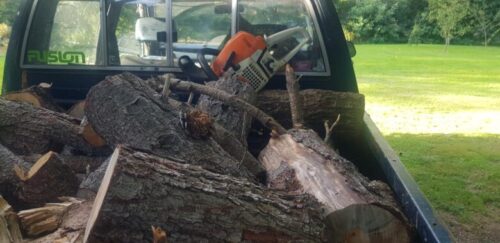Gas vs. Electric Chainsaws – A Cutting Edge Battle
The decision to go with a gas powered chainsaw OR an electrically powered chainsaw is not always that straight forward.
Choosing the right chainsaw can be challenging, especially when there is such a variety of options available.
This article aims to compare the pros and cons of gas versus electric chainsaws to help buyers make a more informed decision.
Gas chainsaws have been the go-to choice for years, boasting powerful engines that can handle demanding jobs in remote locations. On the other hand, electric chainsaws, both corded and cordless, have gained popularity in recent years due to their eco-friendliness and ease of use.
While gas chainsaws typically excel in power and cutting capacity, electric models often offer benefits such as minimal maintenance requirements and are quieter.
By understanding the strengths and weaknesses of both gas and electric chainsaws, potential buyers can weigh the factors that matter most to them. This may include considerations like intended usage, portability, environmental impact, and budget constraints.
Armed with this knowledge, buyers can confidently choose a chainsaw that meets their specific needs and preferences.
Gas Chainsaws – The Traditional Option

Chainsaw precision!
Gas chainsaws are the traditional choice for cutting wood and have been the go-to option for many years.
These are powered by an internal combustion engine that usually runs on 2 stroke gasoline, making them suitable for heavy-duty outdoor use.
They typically are more powerful and robust than their electrically driven counterparts.
2 cycle gas chainsaws can work for longer periods.
As long as you have a supply of the correct gas close at hand, all you need to do is refill the tank at regular intervals, and you can keep working! This makes them especially suitable for large jobs that take a long time to complete..
On the downside, maintenance is a crucial and ongoing undertaking. This includes cleaning the air filter and spark plug, refilling the fuel and oil mix, and very often, fiddling with the carburetor!
Electric Chainsaws
Electric chainsaws fall into two main categories: corded and battery-powered. Both types are generally lighter and quieter than gas chainsaws, and they do not produce any harmful emissions during use.
Corded Chainsaws:
Corded electric chainsaws require a power source, which means they must be connected to an electrical outlet during use. This restricts mobility, making them more suitable for small tasks and indoor projects.
Battery-Powered Chainsaws:

Battery-powered chainsaws, also known as cordless chainsaws, offer greater mobility and convenience compared to their corded counterparts.
They are powered by rechargeable batteries, which typically provide 30 minutes to 1 hour of cutting time per charge.
Some of the smallest chainsaws available are battery powered mini chainsaws that are designed to be used with one hand and typically have a bar length of between 4 inches and 8 inches.
Pros and Cons: Gas vs Electric Chainsaws
Gas Chainsaws Pros and Cons
Gas-powered chainsaws are often preferred for their power and capability to handle larger tasks. Some advantages of gas chainsaws include:
- Power: Gas-powered models typically have more power than electric chainsaws, making them better suited for larger, more demanding jobs.
- Portability: Since they do not rely on an electrical source to function, gas chainsaws can be used in remote locations or where electricity is not readily available.
- Longer run time: Gas chainsaws can run for longer periods without interruption, as they are not limited by battery life.
However, there are also some disadvantages of gas chainsaws:
- Higher maintenance: Gas-powered chainsaws require a mix of gasoline and oil to run, and also need regular maintenance such as cleaning air filters and changing spark plugs.
- Heavier: Generally, gas-powered models are heavier than electric chainsaws, which can make them more challenging to handle for extended periods.
- Noise and emissions: Gas chainsaws produce more noise and emissions than their electric counterparts, which can be a concern in residential areas or for environmentally conscious users.
Electric Chainsaws Pros and Cons
Electric chainsaws come in both corded and battery-powered models. They are typically favored for their convenience and lower maintenance requirements. Some advantages of electric chainsaws include:
- Easy to start: Electric models feature an easy on/off switch, making them quicker to start than gas-powered chainsaws.
- Lower maintenance: As they do not require gasoline or oil to function, electric chainsaws have fewer maintenance tasks compared to gas chainsaws.
- Quieter operation: The average electric chainsaw noise level is far below that of gas-powered models, making them a more suitable choice for residential areas.
Nevertheless, electric chainsaws have some drawbacks as well:
- Limited power: Electric chainsaws usually offer less power than gas-powered models, which can make them less suitable for heavy-duty tasks.
- Corded models: Corded electric chainsaws are restricted in their range and portability due to the need for a power source.
- Electric Chainsaw Battery Life: Battery-powered chainsaws often have a limited runtime, usually 30 minutes to 1 hour, depending on battery capacity.
Each type of chainsaw has its own set of pros and cons, and the choice between gas-powered and electric models will depend on factors such as intended usage, power requirements, and personal preferences.
Power and Performance

When it comes to power and performance, gas and electric chainsaws have their respective advantages and disadvantages. Understanding the differences between these two types of chainsaws can help you make an informed decision based on your specific needs and preferences.
Gas chainsaws are generally more powerful than electric chainsaws, making them ideal for heavy-duty cutting tasks, such as felling large trees and cutting thick logs. The performance of a gas chainsaw is measured in terms of engine size (cubic centimeters or cc) and its cutting speed is usually higher than that of an electric chainsaw. This increased power allows for faster, more efficient cutting, which can be important for professional users or those with large properties to maintain.
Electric chainsaws, on the other hand, come in two varieties: corded and cordless (battery-powered). The power of a corded electric chainsaw is measured in amps, with a common maximum of 15-amps in home electrical sockets source. Although electric chainsaws may lack the raw power of gas models, they still provide enough power for small to medium-sized jobs around the home, such as trimming branches or felling small trees.
Cordless electric chainsaws run on battery power, with their performance limited by the battery’s charge and capacity. A typical cordless electric chainsaw can provide 30 minutes to 1 hour of cutting time before the battery needs recharging source. While this may be sufficient for occasional tasks or light-duty yard work, it might not be enough for prolonged or heavy-duty cutting jobs.
In terms of cutting speed, gas chainsaws still hold an advantage over electric chainsaws. Due to their more powerful engines, gas chainsaws can cut through wood at a faster rate than electric chainsaws. However, the cutting speed of new electric models has improved significantly, making them a viable option for many users source.
In summary, gas chainsaws provide more power and faster cutting speeds, making them suitable for heavy-duty cutting tasks and professional use. Electric chainsaws are generally less powerful but offer the convenience of corded or cordless operation, making them a good choice for small to medium cutting tasks around the home.
Maintenance and Ease of Use
When comparing gas and electric chainsaws, maintenance and ease of use are essential factors to consider. Each type has its advantages and disadvantages, which we will discuss in this section.
Gas Chainsaws
Gas chainsaws are powerful and have no cord limitations, making them suitable for heavy-duty tasks and cutting large trees. However, they require more maintenance than electric models. Some of the key maintenance tasks for gas chainsaws include:
- Regularly checking and replacing the air filter
- Cleaning or replacing the spark plug
- Ensuring proper fuel/oil mixtures
- Regularly inspecting and adjusting the chain tension
Starting a gas chainsaw can be tricky for some users, as it requires the use of a pull cord and the proper starting technique. This often involves adjusting the choke position and priming the carburetor. Additionally, gas chainsaws can emit fumes and are typically much louder than their electric counterparts.
Electric Chainsaws
Electric chainsaws come in two varieties: corded and battery-powered. In general, electric models require less maintenance than gas chainsaws. Some advantages of electric chainsaws include:
- No engine maintenance, simplifying the overall maintenance process
- Easy on/off switch, enabling a quick and effortless start
- Little to no emissions, resulting in a more environmentally-friendly choice
- Quiet operation compared to gas chainsaws
Electric chainsaws do have some limitations, as well. Corded models may restrict the user’s range due to the need for a power source, and their cords can be a tripping hazard. Battery-powered chainsaws might not provide the same level of power as a gas chainsaw (is this Makita an exception?) and their runtime is limited by battery life.
In conclusion, both gas and electric chainsaws offer varying degrees of maintenance and ease of use. Gas chainsaws tend to be more powerful but require more maintenance, while electric chainsaws are easier to maintain and usually lighter, quieter, and more environmentally friendly. The choice between the two will depend on the user’s needs, preferences, and the specific tasks they plan to perform.
Environment and Noise Pollution

Unsurprisingly, both types of chainsaws have a negative impact on the environment. These include their engine emissions and the noise they make while operating. These aspects affect not only the environment but also the person operating the saw!
Electric chainsaws are clear winners when it comes to harmful emissions. Being electrically powered, they do not emit any harmful gases, making them the more eco-friendly option.
On the other hand, gas powered chainsaws produce emissions in the form of exhaust fumes. These not only cause air pollution, but also contribute to the build up of greenhouse gases in the atmosphere. They are thus a less environmentally friendly option.
In terms of noise levels, electric chainsaws are generally quieter than their gas-powered counterparts. This makes them a better choice for users working in residential areas or for those who prefer a less noisy working environment. Gas chainsaws, while more powerful, can be quite loud and may require hearing protection during prolonged use.
However, it’s important to note that both types of chainsaws will produce some noise during operation. The specific noise level will vary depending on the model and power output of the chainsaw. To minimize noise pollution, choose a chainsaw with an appropriate power level for your needs and follow proper maintenance guidelines.
In summary, electric chainsaws hold the advantage when it comes to environmental impact and noise levels. They produce zero emissions and operate more quietly than gas chainsaws, making them a suitable choice for eco-conscious users and those working in noise-sensitive areas.
Safety First Please

When comparing gas and electric chainsaws, safety is a crucial factor to consider. Both types of chainsaws have their safety features and potential risks; however, their differences can influence your decision making.
Electric chainsaws are generally considered safer due to their lower power output and lighter weight, making them easier to control and maneuver. Additionally, they typically have reduced vibration, decreasing the likelihood of accidents caused by sudden or uncontrolled movements. Furthermore, electric chainsaws produce less noise, helping to maintain better situational awareness during use.
One of the safety features present in both gas and electric chainsaws is the chain brake. This mechanism stops the chain from spinning in case of a sudden kickback, protecting the user from potential injury. Kickback occurs when the chain’s tip comes into contact with an object, causing the saw to jerk back towards the operator. Chain brake systems in electric chainsaws are often designed to activate more quickly than their gas-powered counterparts, providing an extra layer of protection.
Another safety aspect to consider is the maintenance requirements for each type of chainsaw. Electric models require less maintenance, as they do not need engine tuning or fuel mix adjustments, reducing the chances of accidents caused by improper upkeep. Gas chainsaws, on the other hand, necessitate regular maintenance, such as cleaning air filters and spark plugs, to ensure safe operation.
Despite their benefits, electric chainsaws may have some drawbacks in terms of safety. Corded models can pose a tripping hazard due to the presence of an extension cord, as well as the risk of electrocution if the cord is damaged or exposed to wet conditions. In contrast, gas chainsaws eliminate these risks, as they do not rely on cords for power. However, the downside of gas-powered models is the presence of flammable fuel, which can pose a fire hazard if not handled properly.
In summary:
- Electric chainsaws:
- Lower power output and lighter weight for better control
- Reduced vibration and noise
- Faster chain brake system
- Less maintenance required
- Possible tripping hazard with corded models
- Gas chainsaws:
- No cord-related safety risks
- Higher power output may be harder to control
- Regular maintenance required
- Flammable fuel poses a fire hazard
When choosing between gas and electric chainsaws, potential users should weigh the safety factors relevant to their specific needs and operating conditions. By carefully considering these factors, you can select the chainsaw that best balances performance and safety for your intended use.
Cost and Affordability
When considering cost and affordability, gas and electric chainsaws have some key differences.
Generally, corded electric chainsaws are the most affordable option, often being about one-third the price of gas chainsaws. However, battery-powered electric chainsaws tend to fall in the same price range as their gas counterparts.
In terms of ongoing costs, electric chainsaws have some advantages. For example, corded electric models have no fuel costs, as they run on electricity provided by a power socket. This also means they are more energy-efficient. Cordless models, however, rely on battery power and may require replacement batteries over time. Battery life typically provides 30 minutes to 1 hour of cutting time per charge.
Gas chainsaws, on the other hand, require fuel to operate. This means that owners need to regularly purchase and mix fuel and oil, incurring an ongoing cost. Additionally, the scent of gas produced while operating can be off-putting for some users.
Price comparisons for popular chainsaw models:
- Electric (corded): Oregon CS1500 18-Inch Corded Electric Chainsaw – Affordable option with no fuel costs.
- Electric (battery-powered): Milwaukee 16-Inch Chainsaw Kit – Comparable in price to gas models, but with the added benefit of being cordless.
- Gas-powered: Husqvarna 20-inch Rancher Gas Chainsaw – Higher upfront cost and ongoing fuel expenses.
In conclusion, while the initial purchase price of electric chainsaws can be more variable, their ongoing costs tend to be lower. Corded models, in particular, offer an affordable and energy-efficient option for many users. But you need to contend with having to take into account an extension cord.
On the other hand, gas chainsaws tend to have a higher upfront cost and require regular fuel and oil purchases, which can add up over time.
Mobility and Weight
When comparing like for like (i.e.same brand of 14″ bar electric vs 14″ bar gas chainsaws) then there is probably not a huge difference in weight (and thus mobility) between gas and electric chainsaws. The one caveat to this statement is that the actual operating weight of a battery powered saw will depend on the battery being used.
The mobility issue is more a function of chainsaw design which is addressed in the following post – The Pros and Cons of Top Handle vs Rear Handle Chainsaws.
Guide Bar length
At the end of the day, longer bar length gas powered chainsaws are more common than their electrically driven counterparts. Most electric chainsaws have a bar length of 16 inches or shorter.
This will no doubt change in the future as battery capabilities ramp up but for the moment this is a fact of chainsaw life. That’s not to say you can’t find electrically driven chainsaws with a 20″ bar – they just aren’t very common!
It’s a Wrap
So there you have it.
There are many factors you need to consider in the electric vs gas chainsaw conundrum. But once you define your needs, then making the decision is likely to be quite easy!
